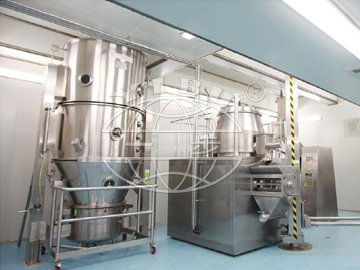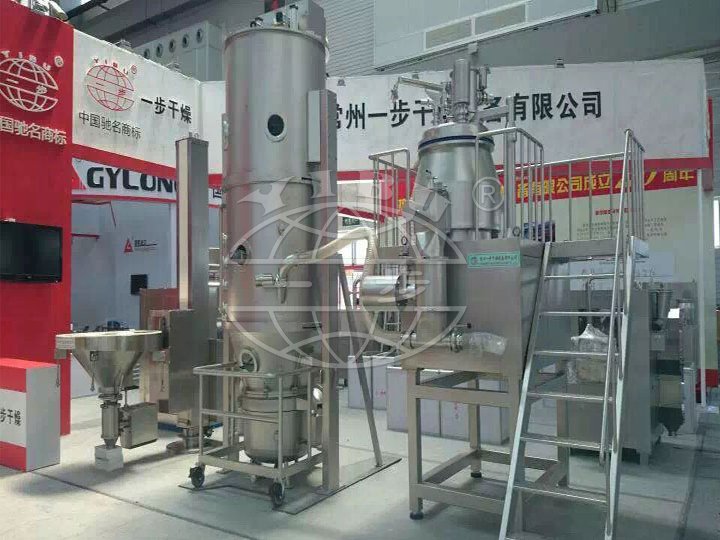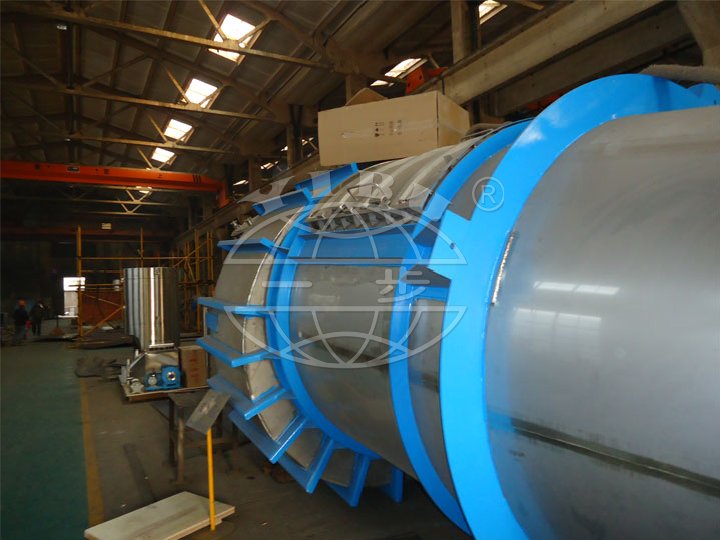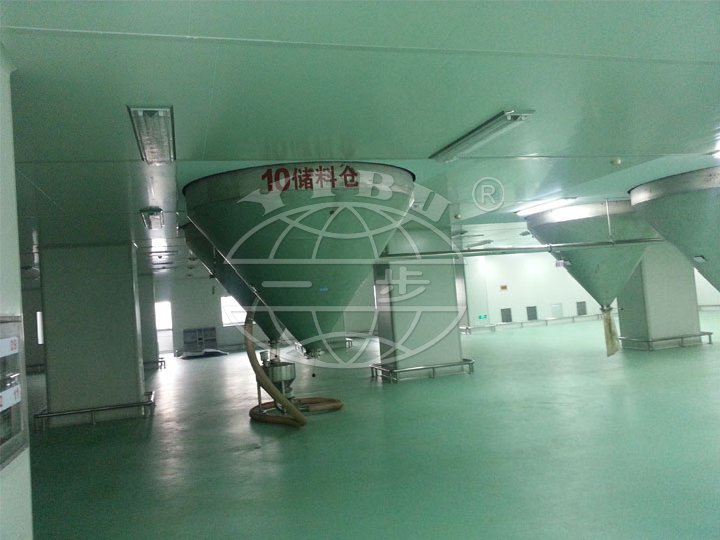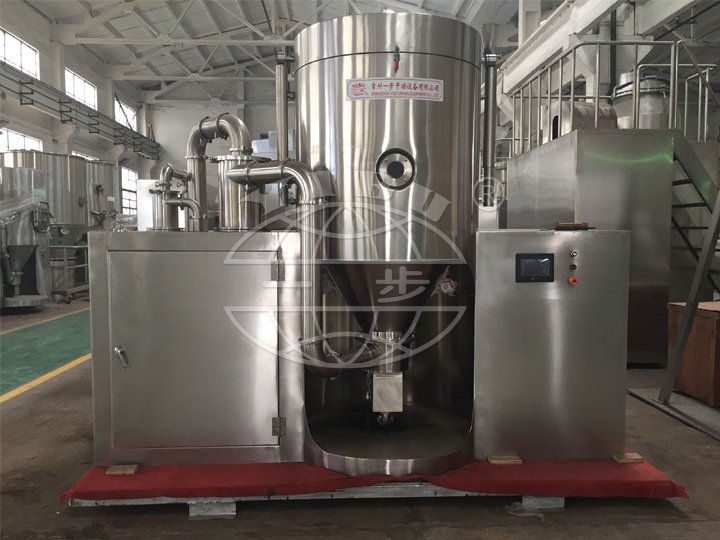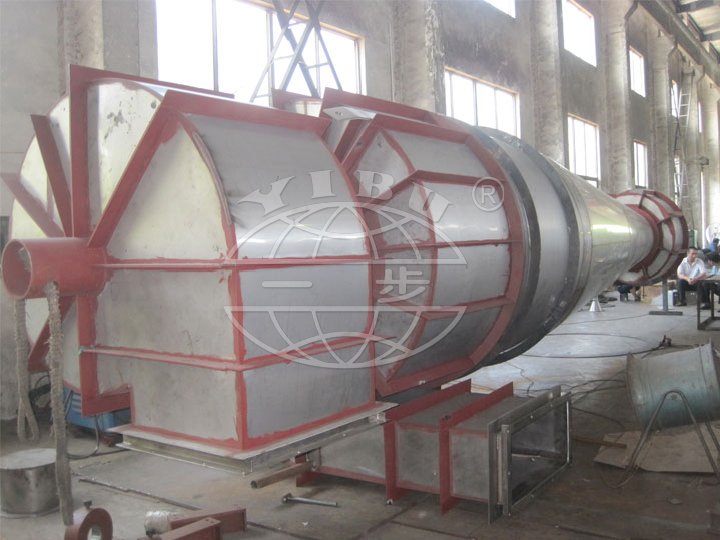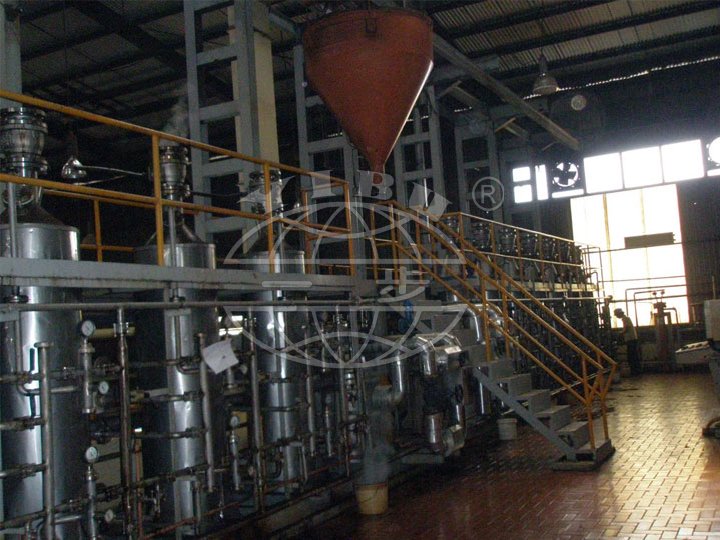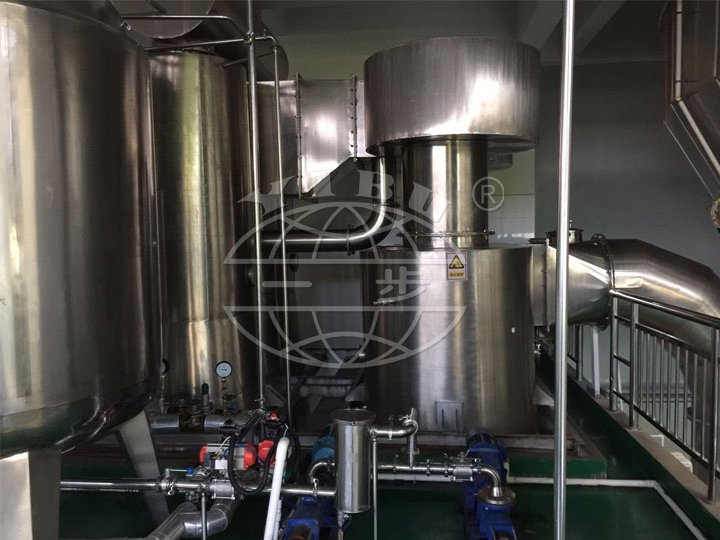Maltodetxtrin production line
Maltodetxtrin Production Line
(Glucose, Maltose and Maltodetxtrin production line)
DESCRIPTION
Use different kinds
of refined starch, such as corn starch, wheat starch or cassava as raw material
to produce glucose or malt dextrin by
the methods of acid hydrolysis or enzyme hydrolysis.
Acid hydrolysis is to
produce some colorful material or non-fermentable sugar easily, because of
adverse effect, in practice this method is stopped. We provide plants with
enzyme hydrolysis to produce glucose or malt dextrin.
Theoretically, when
DE value is less than 20%, i.e., reducing sugar contents is less than 20%, it
is called as malt dextrin. But in daily use, the separation is not very clear.


Process Description
ⅰ. Liquefaction
Glucose amylase used for saccharifying is kind of exoenzyme, hydrolysis from substrate molecules non-reducing end. In order to increase the chance of maltogenic amylase, speed up the reaction of saccharifying, it is necessary use а-amylase make the macromolecular glucose hydrolyze into maltodextrin and compound sugar. But the crystalline structure of starch particles has strong resistance of the enzyme. For example, the speed proportion between bacterial a-amylase hydrolyze starch particles and the hydrolyze starch is 1:2000. Because of this, it is not allow amylase directly act on starch, so starch milk need to be heated first, then the starch hydrate and expand, past and destroy their crystalline structure.
(ⅰ). Gelatinization and aging
If the starch milk be heated into certain temperature, the starch particles begin to expand, polarized cross is disappeared. With the temperature is higher, starch particles continue to expand to several times bigger or scores times bigger than original volume. As particle expend, crystalline structure disappeared, volume expand, particle contact each other, become into gelatinous liquid. Even stop the stir, starch is no longer deposit, this phenomenon is known as gelatinization. Generated sticky liquid is known as starch paste, this phenomenon temperature is the gelatinization temperature.
Starch aging is actually the gelatinized starch intermolecular hydrogen bond has been broken and rearrange to form a new hydrogen bonding process is a complex crystallization process.
(ⅱ). Liquefaction
Liquefaction has many methods, the most ideal way is the jet liquefaction, from the various factory’s production conditions, when the vapor pressure ≥0.8Mpa, choose the high pressure steam jet liquefaction process; when steam pressure ≤0.5Mpa, choose low pressure jet liquefaction, the jet liquefaction process is divided into the once enzyme process and two times plus enzyme technology.
If generated glucose and fructose syrup product, take potato as raw materials to do enzyme process. Take corn wheat starch, if the starch quality is good(protein ≤0.3%), think of adding one time enzyme ,which is easy, save steam, liquid color is light apply to one enzyme. If the starch of corn or wheat with low quality(protein >0.6-1.0%), add this kind of starch, easy to aging and easy to produce insoluble starch granules, so the protein content of raw material should be high, and apply to two times plus enzymatic, can be completely liquefied.
ⅱ. Scarifying
When the liquefaction is finished, quickly adjust the solution’s PH to 4.2~4.5, at the same time cooling down to 60ºC, then add scarifying enzyme, keep the temperature 60 ºC. Keeping stirring to prevent uneven scarifying, after reaction, After inspection with anhydrous alcohol and find that there’s no maltodextrin, adjust the PH value to 4.8-5.0, and heat the solution to 80ºC, keep the temperature for 20 minutes, and then to filter. Store the liquid in filtered solution into the storage tank, keep above 60ºC temperature for further use.
ⅲ. Filtering
After starch saccharifying, DE could be up to 98% (varies as per the configuration and customer’s requirements), but the starch hydrolyzed, it also takes insoluble impurities and ashes, fat, protein and so on, meanwhile in the procedure of hydrolysis, add some impurities, if we add acid, may bring inorganic salt, add enzyme, bring protein, in the procedure of decomposition, generate amylose and oligose, generated 5-HMF in the secondary reaction and other colorful materials and so on, they are need to be refined, so to improve the quality of glucose and quality of finished products. Therefore after saccharifying, it is necessary to make filtration.
After inspection with anhydrous alcohol and find that there’s no maltodextrin, stop Saccharifying, adjust PH4.2~4.5 to 4.8~5.0, and heat up to 80ºC, keep for 20 minutes, then start filtering. There’re different kinds of filtering ways: plate and frame pressing filter, rotary vacuum drum filter, membrane filter, and centrifuge etc. Balancing the operation cost, investment, and quality of product, we normally use plate and frame pressing filter.
ⅳ. Decoloring
Decoloring the saccharified liquid of enzyme method is normally to adjust the PH around 4.8, The enzyme is kind of protein itself, the solution’s PH is close to the protein isoelectric point, there is many suspended substances, many factories first use drum filter, which is made by diatomite pre-coating, or add used active carbon filter to remove the protein, fat and impurities, then do decoloring. The color of the saccharified liquid with enzyme method is light, we normally use twice decoloring with active carbon, and then do Iron Exchange (IX). Or sometimes not use active carbon for decoloring, but drum filter directly and then go for Iron Exchange.
In our process, decoloring is mainly made by plate and frame pressing filter. To improve automatic control level and the operation environment, some western manufacturers use candle filter, which is consist of many filter tubes or sticks, such as DDS Filter (increase thickness), it is cylinder container or closed square container, inner has micro-filter, which is made by mental or ethylene. Before filtering, the liquid is pumped from the bottom of filter. The impurities stay in the filter, clean filtered liquid is pressed out from the top filter tube. When the filtering speed is low, please stop filtering, back wash them and then start filtering again.
ⅴ. Ion exchange (IX)
With the exchangeable ions on the functional groups fixed on three-dimensional network skeleton, changing ion concentration and other environmental conditions, so that it can repeat reversible exchange with external ion, and make the ion separation, replacement, concentration, removal of impurities and chemical catalytic purpose.
The ion exchange resin skeleton structure is fixed, reversible exchange is only done on the functional groups, so it can renewed and used thousands of times. But there is loss of material as they aged. The difference between ion exchange and other agent is that ion exchange material can be renewed many times, the service life is long, so to simplify the production process, shorten the production time, improve product quality, increase the efficiency and reduce costs.
After exchange, hydrogenates resin is changed to sodium resin, and loss resin exchange ability. If put the resin into high concentrated (around 5%) strong acid (regenerating agent), such as hydrochloric acid, therefore the hydrogen ion concentration is high. because of the difference of the concentration, it is easy to exchange sodium resin into hydrogen ion, recover the exchange capacity, this is regeneration process.
ⅵ. Evaporation and concentration
Depend on processing requirements and technology, there’re different types of concentrator, such continuously evaporation or batch evaporation, once evaporation or multi times evaporation. The typical evaporation has two types.
The traditional type consists of two evaporator: one multi-effects (normally 3 or 4 effects) evaporator and one single effect evaporator. A lot of factories are using twice evaporation, first evaporator concentrate the dilute glucose solution to 45-60obx with three or four effects falling film evaporator, and then use a single effect evaporator to make the solution to 72-85obx. In the single effect evaporator, the feeding might be continuous, but discharge has to be in batches.
We are using once evaporation these days. It works very well for glucose with enzyme method, and could make the final product up to 85obx or even higher. The initial solution of enzyme method is normally around 35obx. The energy consumption is much lower compare to traditional process.
ⅶ. Crystallization
Crystallization is the process that makes the liquid into solid and separate the solid. It is also the most important method to get purities. Crystallization is the most important procedure in crystal glucose process. It directly influences the product quality and product yield.
There’re different kinds of crystallization for glucose process. The process is kind of complicated, mainly relating to product quality and product yield. Here to describe the process as below:
(1) Once crystallization process
The liquid is to be crystallized directly after concentration, and then discharge the mother liquor directly without circulation. The equipment of this process is simple, and the quality of the product is good, but the product yield is low, normally, just around 50%. It applies for the factories which utilize the mother liquor for other applications.
Sometimes, we circulate the mother liquor to increase the yield to be around 80%, but the quality of product is not very good.
(2) Twice crystallization process
In this process, most the mother liquor from the product separation flows back for first crystallization after decoloring and Iron Exchange processes. The wet crystal after separation is only used as the material of second crystallization or for the industrial applications.
The mother liquor is mostly reused, so quality from first crystallization is poor. But from all the system, the final product is from secondary crystallization, the quality is much better. Most of the materials are recovered and the product yield is high. This is most the important process to produce glucose for pharmaceutical applications.
(3) Anhydrous glucose production line
This process is one kind of twice crystallization process specialized to produce anhydrous glucose. The quality of the product is very high. Part of the mother liquor is to be used to produce low quality glucose, or used for other applications.
ⅷ. Separation and drying
(1) Separation
The mixture after crystallization contains particles of crystal and un-crystallized liquid (usually called mother liquid or greens), it is necessary to separate crystal glucose particles from mother liquor by centrifugal separator.
Load the liquid mixture and then rotated it by the centrifugal force, then the crystals are threw from the mother liquor into the basket and been discharged.
(2) Drying
Glucose drying machines include drum dryer, air stream dryer, and fluid bed dryer etc, some factories are using spray dryer to dry the high concentrated glucose solution directly to powder.
The drum dryer is rotating drum with steam jacket, drum has certain slope, glucose can be added from one side, it is slow flows in the barrel about 5r/min, such as 1000*5000mm drum dryer, with the capacity of around 10t/d.
Air dryer is the most common glucose drying machine, which consists of air heater, blower, air pipes, and cyclone etc. The separated glucose should be crashed first, and then brought up by the heated hot air flow. In the airflow dryer, the air inlet temperature is around 70-75ºC, while the exhaust temperature is around 30~35ºC, and the airflow speed is around 20m/s. Assume the air tube diameter is 400mm, length is 18m, air velocity is 8000m3/h, air pressure 4900Mpa(500mmH2O), the production capacity is around 10t/h.
Fluid bed dryer is another type of airflow dryer. The hot air flow up from small holes of at the bottom of fluid bed, so the glucose on the perforated plate are fluidized. The air flow absorbs moisture, separate the fines in the cyclone, and is exhausted. The product is then dried. In order to guarantee the product quality, it is necessary to add cold air device device at the second part, so to reduce the temperature of dried glucose. It is the best to reach few degrees above the room temperature. Then these’s no caking after packaging. Please make sure the cold air is dehumidified, so the dry glucose will not absorb moisture from the air.
Spray drying is not common for glucose process. The product is very sticky, so cloth bog filter cannot work. The product is also very fine, the collection rate of cyclone is relatively low. Anyway, we have made some special designs to increase the performance. Even spray dryer is not recommended, but if customer prefers using spray dryer, or the process requires only spray dryer, we could also make special designs.
Drying section is very important part in glucose production line. All product contact parts and inlet processing air contact parts should be made of quality stainless steel, and all inlet air should be purified to high class.



Maltodextrin is divided into three main classes:
MD100: DE value,%(m/m)≤10
MD150: DE value,%(m/m)≤15
MD200: DE value,%(m/m)≤20
(MD is the abbreviation of maltodextrin).
There’re three main characteristics to identify the quality of maltodextrin:
Appearance: white or very light yellow powder, no visible impurities.
Smell: with special smell of malt dextrin, without foreign smell.
Taste: no sweet or slight sweet, odorless, without other taste.
We normally use specially designed spray dryer after concentration for maltodextrin productions. Our special design saves working space, increases heating efficiency, the cleaning is easy, and the investment on workshop is low.
ⅹ. WIP (Washing In Place)
Different level of WIP system are provided on customer’s request
Special Features of Our Design
Compare to traditional technology which is still supplied by a lot of suppliers in the world, our design has the following special features:
1. Enzyme dosing and inactivation: Traditional once enzyme once dosing process will generate much more oligose, more insoluble ingredients. We are using twice dosing system to improve the quality of product.
Compare to the normal processes, our design of enzyme inactivation is very good for protein solidification and uniform dispersing of starch.
2. Jet cooker: Easy control and low steam pressure are the special features of our design.
Instead of control the steam pressure, we are using the liquid level to control the jet cooking process. It is quite difficult to keep the steam supplying pressure very stable, while it is simple to control the liquid level.
We have two kinds of jet cooker for option: low pressure cooker and high pressure cooker. With low pressure cooker, the steam pressure required is only around 2bars. So it is very easy to utilize waste steam. Even for high pressure jet cooker, the steam pressure required is also quite low compare to traditional technology: we are using 6bar while traditional technology normally requires more than 10bars.
3. Liquefaction: multi-laminar flow tanks ensure the uniform liquefaction with the same temperature and same processing time. This is very good for the next process, scarifying.
4. Concentration: one evaporator to achieve high brix, low steam pressure required and energy saving are the main features of our process
When the required product with high brix, traditional technology consists of one 3 or 4 effects falling film evaporator and one single effect evaporator. The problem is that the steam consumption of the single effect evaporator is very high, and the quality of the product is low. We are using one evaporator with 4 or 5 effects, sometimes 6 effects to make the final product of 85 brix or even higher.
The steam pressure required for traditional multi-effects falling film evaporator is normally more than 6bars, while we are using less than 3bars, even 1.5bars steam could also work.
Our design also focuses on energy saving. With our 5 effects falling evaporator, it only consumes around 0.15kg of steam to evaporate 1kg of water.
5. Our filtering and decoloring arrangements are specially design, so to have very clear product.
6. De-odor pole is provided after Iron Exchanging pole
7. All the waste steam, water and heat generated from the plant are considered to be utilized.
8. Spare tanks are considered, so we could keep the production non-stop while change product.
Friendly Reminder
1.This kind of plant are made based on customized design. Not all the features are provided with all designs. The real configurations should be made as per the Contracts or Agreements signed.
2.The material for manufacturing the machine can be AISI304 ,316L and so on . It depends on the customer request.
3.For the heating method , it can be steam ,electricity ,gas-furnace and so on .
4.For the control system , we can design simple push button , and PLC+HMI is also available for customer ,we can design the control system on request .
- 2024-06-08 > Exhibition Invitation |ACHEMA 2024, Germany
- 2019-06-15 > P-MECH CHINA 2019 YIBU BOOTH NO: N3B10a
- 2019-04-15 > YIBU will attend the 57th CIPM Exhibition held in Changsha in Hunan province
- 2018-12-28 > Actived carbon particle mesh belt dryer made for Ingrevity
- 2018-03-10 > big spin flash dryer and spray dryer delivery to pakistan and Italy customer on time
- 2017-12-29 > two sets high speed centrifugal spray dryers and three sets of drum dryre delivered to Indonesia
- 2017-08-24 > one set of LPG-100 spray dryer is delivered to America
- 2017-08-24 > Five layers mesh belt dryer is sucessfully delivered to Manila(Philippines)
- 2017-04-05 > Exhibition interpack 2017 in Dusseldorf In Germany
- 2016-11-23 > The 18th International Exhibition in Moscow


